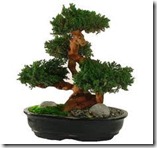 Most of the time, your bonsai tree will be either a conifer or deciduous tree. Sometimes, fruit trees will be part of the collection. There are a number of exotic choices that you can select if you want to expand your skills as a bonsai artist.
Most of the time, your bonsai tree will be either a conifer or deciduous tree. Sometimes, fruit trees will be part of the collection. There are a number of exotic choices that you can select if you want to expand your skills as a bonsai artist.
Wisteria is an excellent choice. A native of China, Korea and Japan, Wisteria can be as tall as 30 feet in the wild. For this reason, turning them into bonsai is an interesting challenge since this species will not conform to any of the typical bonsai styles.
The flowers of the wisteria can be a variety of colors, including blue, purple, pink and white. These flowers are gorgeous and can have a strong aroma, which is an additional benefit. This tree will bloom in the springtime and they need plenty of water, so a pot for this bonsai will need plenty of drainage. Needing full sun to partial shade, you will need to provide plenty of fertilizer to the wisteria tree in spring just prior to their first bloom. Again, you will want to add more nutrients in the late summer while the leaves are still present.
Orange jasmine is a great option for a bonsai challenge as well. These trees are also both beautiful and have fragrant, white blossoms that have a bright red fruit that complement the tree. These trees need to be fed every month or so starting in the early spring and continuing until mid-fall. Although they need more water in the hotter times, they require only a light watering throughout the season.
The orange jasmine bonsai tree should be raised indoors because they grow better in moderate shade with filtered sunshine.
Mimosa or silk trees are another great option. These trees are very fragrant and have long silky filaments that are very captivating looking. With lacy foliage and puffy flowers, they can make great bonsai trees.
The flowers of the mimosa tree will bloom from late April to early July and should be given a moderate amount of water here. You will not want to water the blooms themselves because this will make them wilt and deteriorate. If you choose a mimosa tree for your bonsai collection, this tree will be one of your biggest. With bigger leaves and a rapid growth rate, you will see that these trees are hard to keep to a smaller scale. Make sure you plan to give them plenty of room on the display setting and a larger pot.
The desert rose is another non-traditional bonsai tree species you can consider. This native of East Africa features bright blooms and can typically grow up to 10 feet tall in the wild with large blooms. Many times, this bushy design complements your standard bonsai set and will need lots of fresh air and sunshine. For this reason, keep them outside for greater success. When it gets cold, however, you will want to bring them inside to protect them since they don’t work well below 50F.

Deprecated: strpos(): Passing null to parameter #1 ($haystack) of type string is deprecated in /home/agriviek8Qv/agriviet.net/public_html/wp-includes/comment-template.php on line 2522